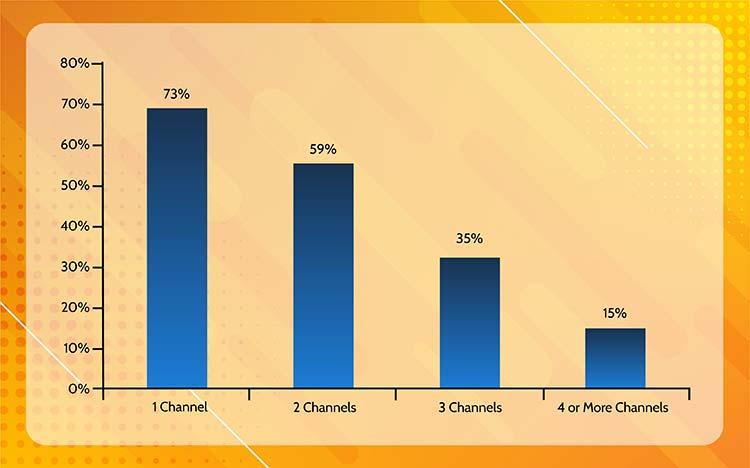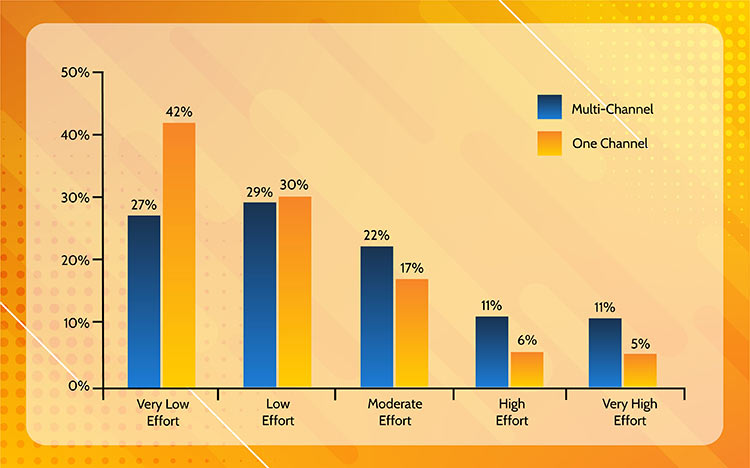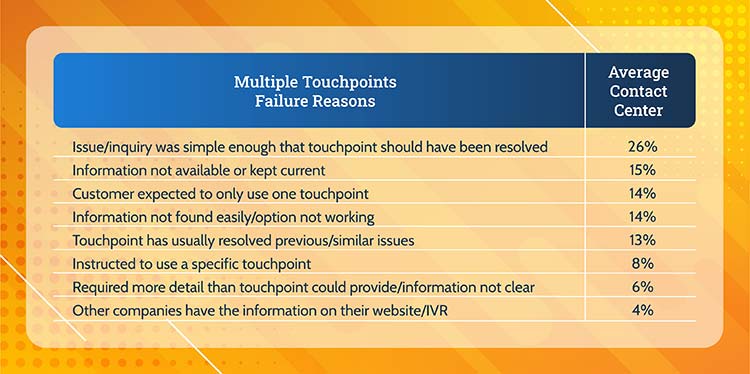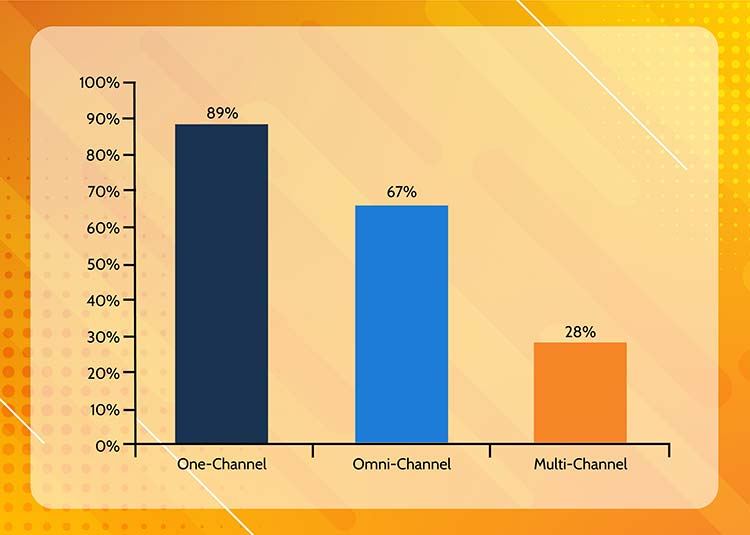Using Multiple Touchpoints Impact on Csat
SQM's CX research shows when customers use a call center touchpoint, 93% of customers expect their call to be resolved on the first call, and if they need to use another touchpoint, they expect it to be a seamless experience. In most cases, when a customer uses multiple touchpoints to resolve the same inquiry or problem, it's the call center, chat, and website touchpoints.
Moreover, our research data reveals that when customers use only one touchpoint (e.g., call center, website, IVR, chat, or email) to resolve their inquiry or problem, Customer Satisfaction (Csat) top box response is 73%. However, Csat drops 19% for each additional touchpoint used to resolve the same inquiry or problem.
The main reason why Csat is so much higher when there is only one touchpoint used is that customer effort was low for resolving their inquiry or problem compared to customer effort required when using two or more touchpoints. Touchpoint, also known as a contact channel and is commonly used interchangeably.
Improving Csat for customers using multiple touchpoints to resolve the same inquiry or problem will be one of the most significant improvement opportunities for contact centers for many years to come.
CSAT DROPS 19% FOR EACH ADDITIONAL TOUCHPOINT USED TO RESOLVE THE SAME INQUIRY OR PROBLEM

Furthermore, the figure below shows multichannel versus one-channel CX for ease of effort in resolving an inquiry or problem. SQM Research data shows that only 27% of customers felt that very low effort was required for contact resolution when using two or more touchpoints to resolve the same inquiry or problem. However, when customers used only one channel to resolve an inquiry or problem, 42% felt very little effort was required to resolve their interactions.
For those customers who had a multi-channel experience, 22% felt that the effort required in resolving their inquiry or problem was either high or very high. In addition, many customers feel that they need to take ownership to resolve their inquiry or problem because they do not think anyone working at the organization will take ownership. As a result, the effort required for the customer to resolve their inquiry or problem is high or very high.
Only 27% OF CUSTOMERS FELT THE EASE OF EFFORT WAS LOW WHEN MULTIPLE TOUCHPOINTS ARE USED TO RESOLVE THE SAME INTERACTION

The figure below shows the main failure reasons when customers use multiple touchpoints to resolve the same inquiry or problem. For example, the number one failure reason was that the customer felt the inquiry or problem was simple enough that the first touchpoint they chose should have resolved their interaction.
Many customers want any touchpoint they choose to resolve their inquiry or problem, especially if they view the interaction as simple. However, customers who use more than one touchpoint penalize the organization with lower Csat.
When the customer uses the call center after using another touchpoint, the customer expects the agent to access all the information they inputted in the previous touchpoint (e.g., website, chat, email, IVR), so they do not have to start the interaction from the beginning. The second biggest failure reason was information was not available from another touchpoint. Therefore the customer needed to repeat themselves to resolve their inquiry or problem, which created high customer dissatisfaction.
MAIN FAILURE REASONS WHEN CUSTOMERS USE MULTIPLE TOUCHPOINTS TO RESOLVE THE SAME INQUIRY OR PROBLEM

CX Touchpoint Delivery
There is much confusion on identifying the differences between one-channel, multi-channel, and omni-channel from a customer experience point of view. Essentially, it comes down to how many touchpoints are used and the depth of the integration between touchpoints. However, to help clarify customer experience differences between the touchpoint operating practices, SQM has developed the following definitions:
- Omni-channel delivery is when a customer has a seamless experience using multiple touchpoints to resolve the same inquiry or problem. Put differently, when a customer used multiple touchpoints to resolve the same inquiry or problem, they were able to pick up from where they left off in the previous touchpoint and, as a result, did not have to start from the beginning.
- Multi-channel delivery is when a customer does not have a seamless experience when using multiple touchpoints to resolve the same inquiry or problem. In other words, the customer had to start their interaction from the beginning each time they used another touchpoint to resolve the same inquiry or problem.
- One-channel delivery is when a customer resolves their inquiry or problem using only one channel. At SQM, we describe this scenario as One Contact Resolution (OCR). The OCR metric measures the percentage of customers who resolved their inquiry or problem on their first call and did not use another touchpoint before or after using the call center. It is essential to understand using one touchpoint to resolve an interaction is what customers expect.
From a customer perspective, few organizations know their customers' satisfaction when using specific contact channels (e.g., IVR self-service, mobile self-service, email, and chat) or when they use multiple touchpoints to resolve the same inquiry or problem.
As a result, SQM is often asked, "What are the differences between one-channel, multi-channel, and omnichannel delivery from a Csat point of view?" The figure below shows Csat (top box response) based on the touchpoint customer experience for resolving a customer's inquiry or problem.
The main finding is that for customers who use only one touchpoint to resolve their inquiry or problem, Csat (top box response) is 89%. On the other hand, when a customer has an omnichannel (seamless) experience for resolving an interaction, Csat is 67%. However, by far the lowest of all the touchpoint customer experiences is when a multi-channel (non-seamless) experience for resolving an inquiry or problem occurs. The bottom line is no surprise; the easier it is for a customer to resolve their inquiry or problem, the higher the Csat.

In Summary
For the question of omnichannel CX being the missing opportunity, SQM believes that improving one-channel delivery should be an organization's priority for improving customer service and operating costs. However, improving omnichannel delivery for resolving an interaction on the first contact should also occur, but only after core touchpoints (e.g., call center and website) are fixed for providing high First Call Resolution (FCR). In addition, it is essential to understand that only 70% of customers experience FCR. Therefore, there is a strong business case to focus on one-channel delivery before improving omnichannel delivery. After all, customers expect to resolve their interaction on the first contact on the touchpoint they choose.
Quick Related Links
First Call Resolution Definition First Call Resolution PPT First Call Resolution Benefits First Call Resolution Strategies First Call Resolution Operating Philosophy FCR Case Study Survey Data Calculate First Call Resolution Top 10 Call Center Metrics VoC Closed-Loop Outside-In or Inside-Out Journey Mapping Concierge Service Sample Size Calculator Good to Great Customer Service CSM Software Software Business Case
